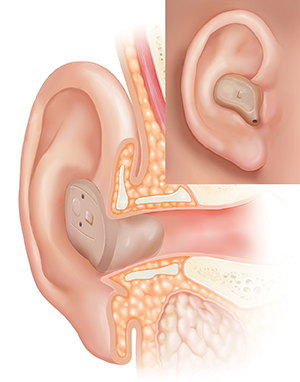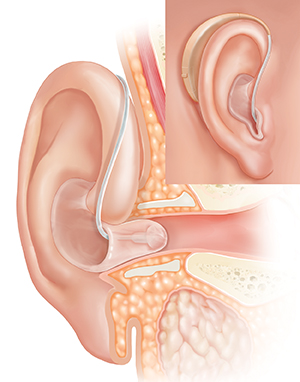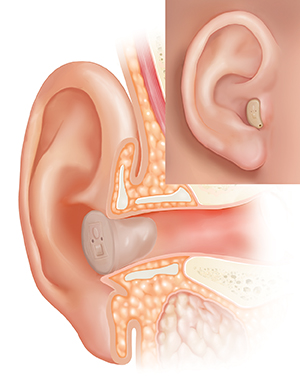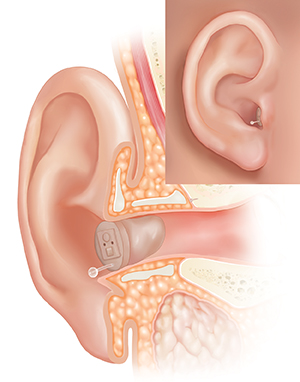Hearing Aids for Children
What are hearing aids?
Hearing aids are small electronic or battery-operated devices that can amplify and change sound. They are used by people with hearing loss. A hearing aid has a microphone that receives sound and changes it into sound waves. The sound waves are then changed into electrical signals.
Millions of children in the U.S. have hearing loss. Hearing aids can help improve hearing and speech, especially for children with a type of hearing loss called nerve deafness (sensorineural hearing loss). This type of hearing loss may be caused by damaged hair cells (sensory receptor cells) in the inner ear. Or it may be from a damaged hearing nerve. Nerve deafness can be caused by:
What are the different types of hearing aids?
The type of hearing aid recommended for your child will depend on several factors. These include your child’s physical limitations, health condition, and personal preference. There are many different types of hearing aids. Companies are always inventing newer, improved hearing aids. But there are 4 basic types of hearing aids available today. See your child's healthcare provider or audiologist for more information on each of these types:
In-the-ear (ITE) hearing aids
These come in plastic cases that fit in the outer ear. They are generally used for mild to severe hearing loss. They can be used with other technical hearing devices. These include the telecoil, a device used to improve sound during telephone calls. But their small size can make it hard to make adjustments. ITE hearing aids can also be damaged by earwax and drainage.
 |
| In-the-ear (ITE). |
Behind-the-ear (BTE) hearing aids
BTE hearing aids are worn behind the ear. This type of hearing aid is in a case. It connects to a plastic ear mold in the outer ear. These hearing aids are generally used for mild to severe hearing loss. They are typically used for young babies and children. Poorly fitted BTE hearing aids can cause an annoying whistling sound (feedback) in the ear. But all types of hearing aids may cause feedback if not fitted well.
 |
| Behind-the-ear (BTE). |
Canal aids
These fit directly in the ear canal. They come in 2 styles: in-the-canal (ITC) aid and completely-in-canal (CIC) aid. Canal aids are custom made to fit the size and shape of your child’s ear canal. They are generally used for mild to moderate hearing loss. But their small size can make them harder to remove and adjust. They can also be damaged by earwax and drainage.
 |
| In-the-canal (ITC). |
 |
| Completely-in-canal (CIC). |
Body aids
Body aids are attached to a belt or pocket and connected to the ear with a wire. They are often used when a child can’t hear anything at all (profound hearing loss). Or they are used if the other types of hearing aids don’t help.
Who may be a candidate for hearing aids?
Most children who have a hearing loss that may be improved with hearing aids can benefit from these devices. The type of hearing aid recommended may depend on several factors including:
-
The shape of the outer ear. Behind-the-ear hearing aids may not fit ears that have an abnormal shape.
-
Depth or length of depression near the ear canal. Ears that are too shallow may not accommodate in-the-ear hearing aids.
-
The type and severity of hearing loss
-
The child’s ability to put in and take out hearing aids
-
The amount of earwax buildup. Too much wax or moisture may prevent use of in-the-ear hearing aids.
-
Drainage. Ears that need drainage may not be able to use certain hearing aid models.
Wearing a hearing aid
Once the hearing aids have been fitted for the ears, your child should begin to slowly wear the hearing aid. Hearing aids don’t restore normal hearing. So it may take time to get used to the different sounds transmitted by the device. Follow these tips when your child is starting to wear hearing aids:
-
In an age-appropriate way, explain the hearing aid to your child and how it will help. Give your child time to ask questions.
-
Be patient and give your child time to get used to the hearing aid and the sound it makes.
-
Start using the hearing aid in quiet areas. Then slowly build up to noisier places.
-
Experiment to see where and when the hearing aid works best for your child.
-
Keep a record of any questions and concerns that you or your child have. Bring this to your child's follow-up exam.
Taking care of hearing aids
Hearing aids need to be kept dry. Cleaning methods vary depending on the style and shape of the device. Other care tips include:
-
Keep the hearing aids away from heat.
-
Batteries should be replaced on a regular basis, often every 1 to 2 weeks.
-
Don't use hairspray or other hair products when the hearing aid is in place.
Things to think about when buying a hearing aid
A medical exam is needed before buying a hearing aid. Hearing aids can be bought from:
-
An audiologist. This is a specialist who can assess and manage hearing and balance problems. You may be referred to an audiologist by your child's ear, nose, and throat doctor (ENT or otolaryngologist). Or the audiologist may work in the same office.
-
An independent company.
Styles and prices vary greatly. Do your research on both hearing aids and the businesses that sell them. Think about these questions when buying hearing aids:
-
Can my child’s hearing loss be improved with medical or surgical treatments?
-
Which design will work best for my child's type of hearing loss?
-
Can my child test the hearing aids for a certain time?
-
How much do hearing aids cost? If money is a problem, are there agencies that can help cover the cost?
-
Do the hearing aids have a warranty, and does it cover care and repairs?
-
Can my child's audiologist or otolaryngologist make adjustments and repairs?
-
Can any other assistive technology devices be used with the hearing aids?
Safety alert
Hearing aid batteries can be very dangerous to children. They can cause serious harm and even death if ingested or inserted into the body. Ways to keep your child safe include:
-
Store spare batteries out of sight and out of reach of children
-
Make sure the hearing aid has a child-resistant battery compartment with a lock that is activated when the hearing aid is being worn
-
Don't insert or change batteries in front of small children
If you believe your child may have inserted or swallowed a battery, call the National Battery Ingestion Hotline immediately at 800-498-8666 and get emergency medical care.